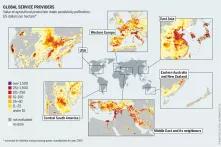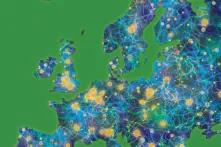Dossier
Insect Atlas 2020
Facts and figures about friends and foes in farming
Insects are a fundamental part of the basis of life in our world. The Insect Atlas offers on 60 pages and in more than 80 graphics a lot of information about the importance of insects.

Agriculture and insect control need an ambitious policy
If we were to count them, every person on earth would have around 1.4 billion insects from an estimated 5.5 million different species. There is an almost unimaginable quantity and variety of six-legged animals with which we share the world. The Insect Atlas shows how the colorful world of insects is connected to our agriculture and food.
It is impossible to imagine a world without insects - that's how important these mostly small creatures are for the functioning of our ecosystems. They pollinate plants, help eliminate dead organisms, improve soil quality and exterminate harmful conspecifics. They are inseparably linked to agriculture and to our food - and yet intensive agriculture is one of the greatest threats to them. We are currently experiencing a dramatic decline in insects in Germany, Europe and worldwide. Many species are threatened, and in almost all species the number is declining. One important reason for this is intensive agriculture. Monotonous landscapes, the use of pesticides, intensive agriculture and less grazing of animals deprive insects of their habitats.
The Insect Atlas shows that it could have pointed agricultural policy in the right direction for a long time. But nothing has happened. Yet the farmers deserve a good policy: one that provides the right incentives for the future. Insect-friendly agriculture must be promoted. In this case, support means concrete financial assistance. e do not pay for insect protection at the cash register. Farmers do not get paid for it. But this is exactly what needs to happen - the best way to do this is for the EU to use the almost 60 billion euros a year with which it supports European agriculture in a targeted way for insect- and climate-friendly agriculture.
But the Insect Atlas also shows that a look at the fields on our doorstep is not enough. The imported feed for the many millions of farm animals that satisfy the global hunger for cheap meat is growing, especially in South America. There, in the world's most species-rich regions, millions of hectares of forest are being cleared and made available for soy and meat production. Now the EU is negotiating a free trade agreement with the "Mercosur" states of Latin America so that even more cheap agricultural products can come to us without trade restrictions - much to the chagrin of the local farmers and insects.
The insect atlas shows what the politicians, the farmers but also every single one of us can do to strengthen insect-friendly agriculture. With the facts and figures in this insect atlas, we would like to contribute to the lively debate on agriculture and insects. At the same time, we want to show how diverse, colourful and worth protecting the world of insects is. Our aim is to show that agriculture and insect protection need an ambitious policy - not only in Germany and Europe, but worldwide. The challenges are great, and in order to meet them, we must seek joint solutions.











